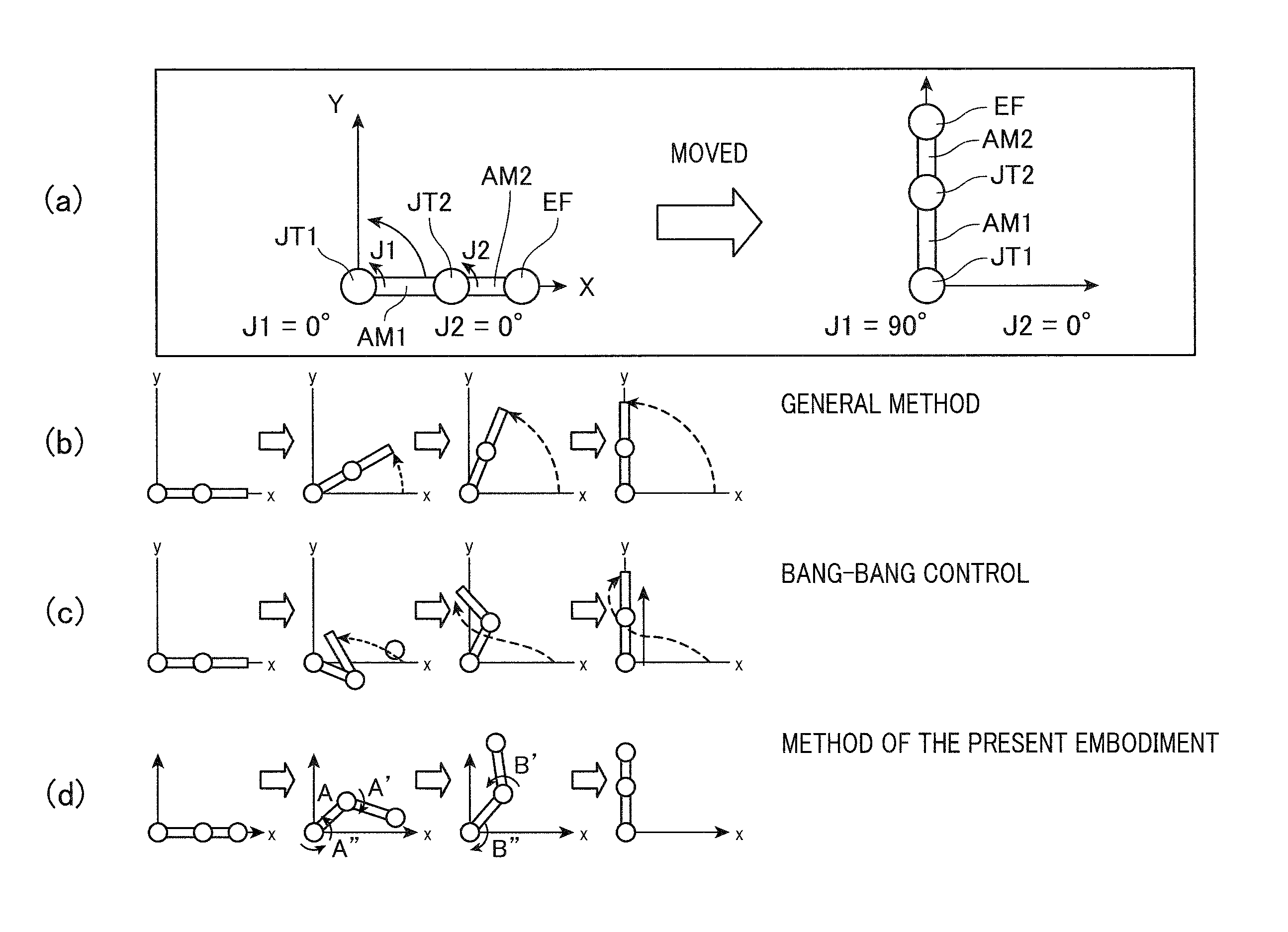Method of generating path of multiaxial robot and control apparatus for the multiaxial robot
a multi-axial robot and control apparatus technology, applied in the direction of electric programme control, programme-controlled manipulators, programme control, etc., can solve the problem that the acceleration/deceleration cannot be minimized at other action points than the action points mentioned, the maximum acceleration changes in a non-linear manner, and the motors are not able to sufficiently exert their performance, so as to prevent the movement velocity of the robot from being enhanced, increase the acceleration required, and increase the deceleration required
- Summary
- Abstract
- Description
- Claims
- Application Information
AI Technical Summary
Benefits of technology
Problems solved by technology
Method used
Image
Examples
first embodiment
[0042]Referring to FIGS. 1 to 11, hereinafter are described a method of generating a path (or trajectory) of a multiaxial robot and a control apparatus for the multiaxial robot, according to a first embodiment of the present invention.
[0043]Before specifically describing an example of the multiaxial robot, referring to FIGS. 1 and 2, an outline of a control method of the multiaxial robot of the present embodiment is described. First, referring to (a) to (d) of FIG. 2, the control method of the present embodiment is described comparing with a control method based on conventional art.
[0044]As shown in FIG. 2(a), let us assume a simple biaxial robot (having axes J1 and J2) in which first and second arms (links) AM1 and AM2 are combined into one arm so as to be movable about two joints JT1 and JT2, respectively. An end effector EF of the robot is moved on the X-Y plane from an angular position (J1, J2)=(0°, 0°) to an angular position (J1, J2)=(90°, 0°).
[0045]As shown in FIG. 2(b), the s...
second embodiment
[0117]Referring to FIGS. 12 and 13, hereinafter is described a second embodiment related to a method of generating a path of a multiaxial robot and a control apparatus for the multiaxial robot.
[0118]In the second and the subsequent embodiments, the components identical with or similar to those in the control apparatus of the first embodiment are given the same reference numerals for the sake of omitting or simplifying explanation.
[0119]In the method of generating a path of a multiaxial robot and a control apparatus for the multiaxial robot according to the second embodiment, there is a change in the timing of performing the step of converting the position x of an end effector to the angle q of each axis. Specifically, in the first embodiment described above, the position x of the end effector is converted to the angle q of each axis by solving the inverse kinematics (refer to step S12). In this regard, in the second embodiment, conversion to the angle q is performed at a stage prior...
PUM
 Login to View More
Login to View More Abstract
Description
Claims
Application Information
 Login to View More
Login to View More - R&D
- Intellectual Property
- Life Sciences
- Materials
- Tech Scout
- Unparalleled Data Quality
- Higher Quality Content
- 60% Fewer Hallucinations
Browse by: Latest US Patents, China's latest patents, Technical Efficacy Thesaurus, Application Domain, Technology Topic, Popular Technical Reports.
© 2025 PatSnap. All rights reserved.Legal|Privacy policy|Modern Slavery Act Transparency Statement|Sitemap|About US| Contact US: help@patsnap.com



